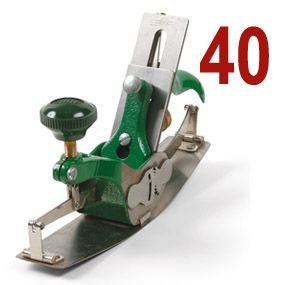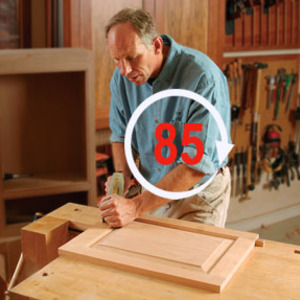
This week on Shop Talk Live, we get to the bottom of the often-misunderstood compass plane, and tackle the age-old question: what's the deal with corrugated handplane soles?
 |
Every two weeks, a team of Fine Woodworking staffers answer questions from readers on Shop Talk Live, Fine Woodworking’s biweekly podcast. Send your woodworking questions to shoptalk@taunton.com for consideration in the regular broadcast!
Click on the link at left to listen to the podcast, or catch it in iTunes. Remember, our continued existence relies upon listener support. So if you enjoy the show, be sure to leave us a five-star rating and maybe even a nice comment on our iTunes page. And don’t forget to send in your woodworking questions to shoptalk@taunton.com.
Shop Talk Live 40: From Compass Planes to Corrugated Planes
![]() On this week’s edition of Shop Talk Live, we answer the “how” and “why” of compass planes and dive into the history of corrugated handplane soles. Plus, Fine Woodworking art director Mike Pekovich fesses up to one of the biggest Smooth Moves in the history of Shop Talk Live! All this, plus your woodworking questions answered on Fine Woodworking’s very own podcast.
On this week’s edition of Shop Talk Live, we answer the “how” and “why” of compass planes and dive into the history of corrugated handplane soles. Plus, Fine Woodworking art director Mike Pekovich fesses up to one of the biggest Smooth Moves in the history of Shop Talk Live! All this, plus your woodworking questions answered on Fine Woodworking’s very own podcast.
Links from this Week’s Show






















Comments
I took the Highway to the Freeway and merged onto the express way.
Like the knotty tip.
Another fine pod. I have always wondered about the corrugated soles - guess I'll keep wondering!
I've been using Polyurethane finishes for most of my work because it's readily available here in Guatemala. Sherwin Williams is one of if not thee most popular brand in this country. I noticed the Polyurethane for floors has a tendency run on vertical surfaces but I must say that is no surprise because it's designed to flatten out I would think. My question is they have Polyurethane for marine, floors, and furniture applications. What is the difference between them?
Gracias
Chuck
Asa might be on to something about the corrugations on Stanley planes...
Lots of "features" are born from the pursuit of manufacturing efficiency. For example, the cup hinge...
Where's that photo of the upside-down dust collector? Thx!
Another great podcast. Would love to see a picture of the signs M.C. made for everyone. (you all can't pronounce his name, so I'm not even going to attempt to spell it)
A.J.
Hi Guys,
You going to be okay if a girl answers this mystery for you? Corregated soles on hand planes were a marketing scheme and nothing more! The corregated sole was promoted as being easier to push across the surface of the wood because the amount of metal was reduced and they may have felt more like the wooden bodied planes they were replacing! That's it, nothing more to it! Go and research old hand plane advertising or talk with Chris Schwarz if you'd like to know more.
You have to remember that the norm for hundreds of years was the wooden hand plane. Along come guys like Stanley who bring along their new-fangled iron bodied planes, well you guys know how it works, the new guy is criticized and attempts to minimize the value or working capabilities of his new planes ran wild, just like they do today when somebody shows up with a back saw that doesn't have a brass back (Veritas)! Then the new guy starts to get a foot hold and the naysayers have less and less to claim so they started belly aching about how metal planes were harder to push across a board! While there can be some truth to that it's nothing a bit of candlwax couldn't improve. However, the iron body plane manufacturers simply ground corregations into the plane sole or in some cases cast designs or their names into the soles of their planes! Obviously metal planes won the day and if corregated bases really did actually make a difference I am certain our friends at Veritas and Lie-Neilsen would be grinding the soles of their planes right now!
Cheers from the Rocky Mountains!
Madison
In one of your recent episodes, you had a rocket scientist discuss that a kick back from a saw only loses speed after leaving the saw. This made the shop teacher who recommended standing behind the saw to protect others sound silly. Well, I have a PhD. in particle physics and I wish to argue on the side of the shop teacher.
You posed the wrong question to the rocket scientist. He was right about what he said, but he was answering the wrong question. The real question should have been, "How does the kickback reach its final speed and how is this different if there is someone blocking it at the back of the saw?"
When I stand behind my saw, the blade is about 13 inches away from my belly. When the kickback starts, the blade only has 13 inches of wood to accelerate backwards before it hits someone behind the saw. This is a fairly short time for the blade to deliver energy into the wood.
If the wood is shorter than this, then indeed it is at full speed and would only slow down if I were not there. Such short pieces don't have a lot of mass and are unlikely to do much damage (assuming my soft belly).
Pieces that are much longer than 13 inches have not reached the full blade speed after kicking back the first 13 inches. The wood would continue to accelerate from the force of the blade and could reach a much higher speed if a belly were not there to stop this. I believe that this is what the shop teacher was trying suggest. These long pieces also have a lot more mass and could do a lot of damage if they are allowed to reach this higher speed.
I think that the question, "Is it safer for me to get a kickback to the belly? or is it safer for me to explain the hole in the garage wall to my wife?" does not have an obvious answer.
Perhaps Fine Woodworking could run some experiments to tell us exactly where the danger zone is.
Log in or create an account to post a comment.
Sign up Log in